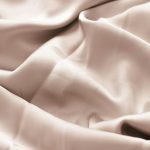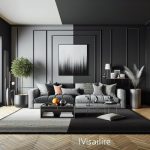You can customize Carbon Kevlar fabric with vibrant colors like Jet Black for sleek style, Classic Yellow for visibility, or Charcoal Gray for a neutral look. The fabric’s strength and lightweight nature stay intact because color is added during fiber production or with safe surface treatments. These options offer both durability and fresh aesthetics, perfect for sleek jackets, automotive interiors, or protective gear. Explore more about techniques, care, and eco-friendly choices to maximize your project’s potential.
Table of Contents
Key Takeaways
- Carbon Kevlar fabrics offer a futuristic texture combining strength with lightweight durability, ideal for sleek, modern custom projects.
- Color choices like Classic Yellow, Jet Black, Deep Blue, and Charcoal Gray balance style with UV resistance and heat management.
- Solution dyeing ensures vibrant, even colors on Kevlar without damaging fiber integrity, allowing for consistent aesthetic finishes.
- Layering and contrasting colors create dynamic visual patterns, adding depth and uniqueness to custom fabric designs.
- Colored carbon Kevlar suits diverse projects, from automotive interiors to wearable tech, enhancing both appearance and functionality.
Understanding the Composition of Carbon Kevlar Fabrics
Carbon Kevlar fabrics combine two advanced fibers—carbon and Kevlar—to deliver exceptional strength and durability.
When you work with this fabric, you benefit from carbon’s high tensile strength and stiffness combined with Kevlar’s impact resistance and lightweight nature. The carbon fibers provide structural support, while Kevlar fibers add flexibility and toughness.
This unique blend makes the fabric ideal for demanding applications that require both strength and resilience. You’ll notice the interwoven structure where these fibers alternate, creating a balanced material that resists tearing and abrasion.
Understanding this composition helps you appreciate why Carbon Kevlar fabrics are favored in industries like aerospace, automotive, and protective gear.
This composition explains why Carbon Kevlar fabrics excel in aerospace, automotive, and protective gear applications.
Knowing the material’s basics lets you make informed choices for your custom projects.
How Color Variations Impact Fabric Performance
Although the primary focus often lies on strength and durability, color variations can greatly influence the performance of Kevlar fabric blends. You’ll find that certain dyes and pigments affect UV resistance, heat tolerance, and even flexibility. Darker colors tend to absorb more heat, which can impact temperature-sensitive applications. Meanwhile, lighter hues usually reflect sunlight, helping keep the fabric cooler.
| Color Type | UV Resistance | Heat Absorption |
|---|---|---|
| Dark | Moderate | High |
| Light | High | Low |
| Mid-tone | Moderate | Moderate |
Choosing the right color means balancing aesthetics with functional demands, ensuring your custom project performs just as well as it looks.
Popular Color Choices in Carbon Kevlar Fabrics
When selecting Kevlar fabric, you’ll notice a range of popular colors that blend both style and function.
These colors not only enhance the fabric’s appeal but also suit various custom projects. Here are four popular choices to evaluate:
- Classic Yellow – The iconic Kevlar hue, recognized for its high visibility and traditional look.
- Jet Black – Offers a sleek, modern aesthetic while maintaining the material’s toughness.
- Deep Blue – Adds a subtle pop of color without compromising the fabric’s professional appearance.
- Charcoal Gray – Provides a neutral, versatile option that pairs well with other materials.
Choosing the right color helps you balance aesthetics with your project’s specific needs, giving your carbon Kevlar fabric a unique, tailored presence.
Techniques for Dyeing Carbon Kevlar Material
Choosing the right color is just the beginning—applying dye to carbon Kevlar fabric requires specific techniques to guarantee the material retains its strength and appearance.
Since Kevlar fibers resist conventional dyes, you’ll need to use specialized methods like solution dyeing or surface coating. Solution dyeing involves adding pigment during fiber production, assuring even color without weakening fibers.
If you’re working with finished fabric, surface treatments such as pigment-based coatings or polymeric dyes can provide color without penetrating the fibers deeply, preserving integrity.
Always avoid harsh chemicals or excessive heat, which can degrade Kevlar’s durability. Testing small fabric samples before full application helps you confirm colorfastness and fabric performance.
Custom Color Blending for Unique Fabric Designs
To create truly unique fabric designs, you’ll want to explore custom color blending techniques that go beyond standard hues. By mixing different pigments and layering colors, you can achieve shades that perfectly match your vision.
Explore custom color blending to craft unique fabric shades that perfectly capture your creative vision.
Here’s how to get started:
- Select Base Colors – Choose complementary or contrasting colors as your foundation.
- Test Small Batches – Blend small fabric samples to see how colors interact before full-scale application.
- Adjust Ratios – Fine-tune pigment quantities to deepen or lighten tones until you get the desired effect.
- Layer Colors – Apply multiple color layers for depth and texture, enhancing visual complexity.
Experimenting with these steps allows you to craft custom Carbon Kevlar fabric designs that stand out and suit your project’s unique style.
Applications of Colored Carbon Kevlar in Automotive Interiors
You can transform your car’s interior by using colored carbon Kevlar to enhance the dashboard’s visual appeal.
Custom seat covers made from this fabric add both style and durability.
Plus, integrating color into door panels lets you create a cohesive, personalized look throughout your vehicle.
Enhancing Dashboard Visual Appeal
While many drivers focus on performance, your dashboard’s look plays a crucial role in defining your car’s interior style.
Using colored carbon Kevlar fabric can instantly elevate your dashboard’s visual appeal with its unique texture and vibrant hues. You can customize it to match or contrast your interior colors for a bold statement.
Here’s how you can enhance your dashboard with colored carbon Kevlar:
- Highlight Key Areas – Wrap around air vents or control panels for a striking accent.
- Create Patterns – Use different colors to form geometric or abstract designs.
- Add Depth – Layer fabrics to produce a subtle 3D effect.
- Blend Function and Style – Maintain durability while upgrading aesthetics with this tough, lightweight material.
This approach guarantees your dashboard stands out without compromising functionality.
Custom Seat Cover Designs
Elevating your dashboard with colored carbon Kevlar sets a stylish tone that can extend to your seats for a cohesive interior look.
You can choose custom seat covers that showcase bold hues or subtle tints, matching or contrasting your dashboard’s color. This fabric not only adds visual appeal but also offers durability and lightweight comfort.
By incorporating patterns or stitching that highlight the Kevlar’s unique texture, your seats become a focal point rather than an afterthought.
Whether you prefer a full cover or accent panels, colored carbon Kevlar lets you personalize your ride while maintaining high performance standards.
With endless color choices, you can create a truly unique interior that reflects your style and enhances your driving experience.
Door Panel Color Integration
When designing your car’s interior, integrating colored carbon Kevlar into door panels can dramatically enhance both style and functionality. This material offers a sleek, durable surface that resists wear while adding vibrant accents.
You can customize your panels to match or contrast other elements seamlessly.
Consider these key benefits when choosing colored carbon Kevlar for door panels:
- Visual Impact: Add bold colors or subtle tones to elevate your interior’s aesthetic.
- Durability: Protect panels from scratches and scuffs with Kevlar’s tough fibers.
- Lightweight: Keep your car agile by using a material that doesn’t add unnecessary weight.
- Easy Maintenance: Clean panels effortlessly without worrying about fading or damage.
Carbon Kevlar Fabrics in Fashion and Wearable Tech
Innovation drives the use of Carbon Kevlar fabrics in fashion and wearable tech, blending style with strength.
When you choose Carbon Kevlar, you get a material that’s lightweight yet incredibly durable, perfect for garments and accessories that need to withstand everyday wear and tear.
Carbon Kevlar offers lightweight durability, ideal for fashion and accessories built to endure daily use.
You can design sleek jackets, backpacks, or even protective gear that looks cutting-edge while offering exceptional performance.
The fabric’s unique texture adds a futuristic aesthetic, making your creations stand out without sacrificing functionality.
Plus, Carbon Kevlar integrates well with electronics, allowing you to embed sensors or lights seamlessly.
If you want your fashion or tech projects to combine resilience with modern style, Carbon Kevlar fabric offers a versatile solution that meets both your creative and practical needs.
Enhancing Visibility With Bright and Reflective Colors
You can boost safety and style by choosing bright colors for your carbon Kevlar fabric, making you stand out in any setting.
Reflective materials add another layer of visibility, especially in low-light conditions.
Combining these options lets you stay both eye-catching and secure.
Bright Color Benefits
Although carbon Kevlar fabric is prized for its strength and durability, incorporating bright and reflective colors can greatly boost its visibility in various settings.
When you choose bright colors, you guarantee your projects stand out and catch the eye quickly, which is vital in safety gear or sports equipment.
Here’s why bright colors matter:
- Increase safety by making objects easy to spot in low light.
- Enhance aesthetic appeal with vibrant, attention-grabbing hues.
- Improve functionality by differentiating parts or sections clearly.
- Support branding efforts through customizable, bold color options.
Reflective Material Advantages
How can reflective materials transform the functionality of carbon Kevlar fabric? By adding reflective elements, you greatly boost visibility in low-light conditions, making your custom projects safer and more practical.
Whether you’re designing protective gear, bags, or accessories, reflective carbon Kevlar fabric guarantees you stand out when it matters most. These materials catch and bounce back light, alerting others to your presence without sacrificing durability or style.
Plus, reflective coatings or threads integrate seamlessly with the fabric’s texture, maintaining its strength and flexibility. When you choose reflective carbon Kevlar, you’re not just enhancing aesthetics—you’re improving safety and performance.
This blend of visibility and toughness makes your projects ideal for outdoor, tactical, or urban environments where being seen can make all the difference.
Combining Carbon Kevlar With Other Colored Fabrics
When you combine carbon Kevlar with other colored fabrics, you reveal a world of creative possibilities that enhance both aesthetics and functionality.
Blending these materials lets you customize your project with unique textures and colors, while maintaining strength and durability.
- Use contrasting colors to highlight carbon Kevlar’s sleek look and add visual interest.
- Incorporate softer fabrics like nylon or polyester for comfort without sacrificing toughness.
- Layer colored Kevlar panels with plain ones to create dynamic patterns and depth.
- Experiment with stitching and seams in different hues to emphasize design lines and structure.
Care and Maintenance of Colored Carbon Kevlar Fabrics
Since colored carbon Kevlar fabrics combine durability with vibrant aesthetics, proper care is essential to preserve their appearance and performance.
Colored carbon Kevlar fabrics blend strength with style, requiring careful maintenance to keep their vibrant look and durability intact.
You should avoid harsh chemicals or abrasive cleaners that might damage the fibers or alter the color. Instead, gently clean the fabric with a mild soap solution and a soft cloth or sponge.
When drying, keep it away from direct sunlight or heat sources to prevent fading or warping. Store the fabric in a cool, dry place, ideally rolled or flat to avoid creases.
Regularly inspect for any signs of wear or damage, addressing small issues promptly to maintain integrity.
Environmental Considerations in Producing Colored Carbon Kevlar
Although producing colored carbon Kevlar fabrics offers exciting design possibilities, it also raises important environmental concerns. When you choose these materials, consider the following factors to minimize your impact:
- Dyeing Process – Traditional dyeing uses water and chemicals that can pollute if not managed properly. Opt for eco-friendly dyes and closed-loop systems.
- Energy Consumption – Manufacturing colored Kevlar requires more energy than standard fabric. Seek suppliers committed to renewable energy.
- Waste Management – Proper disposal or recycling of chemical waste prevents soil and water contamination.
- Sourcing Raw Materials – Sustainable sourcing of carbon and Kevlar fibers reduces environmental strain and supports ethical practices.
Being aware of these factors helps you make greener choices without sacrificing your project’s aesthetic appeal.
Future Trends in Carbon Kevlar Fabric Colors and Patterns
As technology advances, you’ll see carbon Kevlar fabrics embracing bolder colors and intricate patterns that push design boundaries.
Innovations in dyeing methods and weaving techniques will let you customize your projects with vibrant hues and dynamic textures previously impossible. Expect more options combining multiple colors seamlessly, creating striking visual effects without compromising strength.
Digital printing on carbon Kevlar will also grow, giving you precise, complex designs tailored to your aesthetic needs.
Additionally, smart fabrics embedded with responsive color-changing properties will become available, allowing your creations to adapt their look in real time.
These trends mean your carbon Kevlar projects won’t just be strong and durable—they’ll also stand out with unmatched style and personalization, reflecting the cutting edge of both function and fashion.
Frequently Asked Questions
What Is the Typical Cost Difference Between Colored and Standard Carbon Kevlar Fabrics?
You’ll usually pay about 20-40% more for colored carbon Kevlar fabrics compared to standard ones. The added cost covers the dyeing process and specialized manufacturing, but prices can vary depending on supplier and quantity you order.
How Do Colored Carbon Kevlar Fabrics Impact Product Weight?
Think of colored carbon Kevlar as a feather with a splash of paint—it won’t weigh you down. You won’t notice any significant weight difference, so your product stays light while looking vibrant and unique.
Are Colored Carbon Kevlar Fabrics UV Resistant?
You’ll find that colored carbon kevlar fabrics usually have good UV resistance, but it depends on the specific dye and coating used. Always check product details to guarantee your fabric will withstand prolonged sun exposure effectively.
What Is the Lead Time for Ordering Custom-Colored Carbon Kevlar Fabric?
You might worry about long waits, but custom-colored carbon Kevlar fabric typically ships within 4 to 6 weeks. If you order early, you’ll get your unique fabric on time for your project without stress.
Can Colored Carbon Kevlar Fabrics Be Recycled Effectively?
You can’t recycle colored carbon Kevlar fabrics easily because their mixed materials complicate processing. However, some specialized facilities recover fibers, but overall, recycling remains limited and less effective compared to pure materials.
- Does Chiffon Fabric Stink - July 15, 2025
- Does Chiffon Fabric Affect the Economy - July 15, 2025
- Does Cotton Fabric Have a Nap - July 15, 2025







